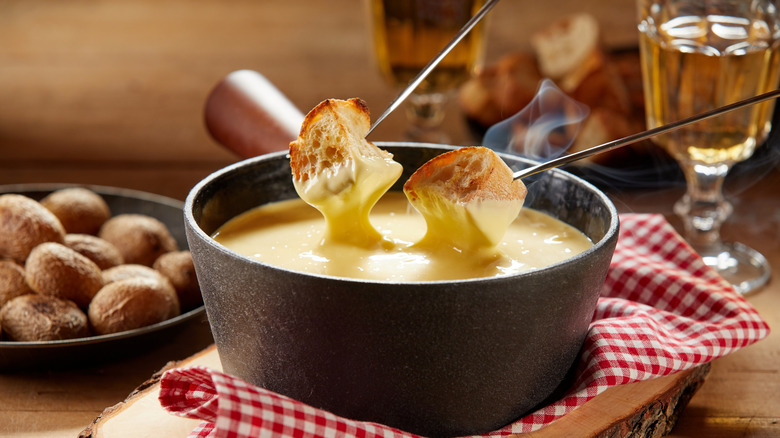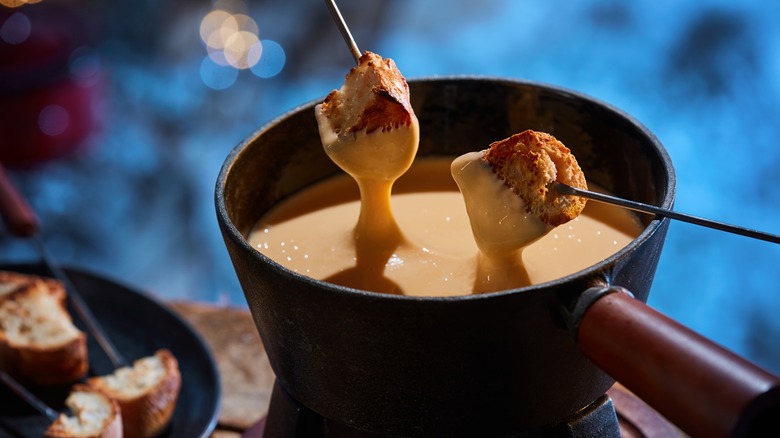Ben Ford's Fondue Alternative That Will Have You Salivating - Exclusive
Swiss fondue may get all of the attention, but once you learn about its Italian cousin, fonduta, you might find yourself running to the store to get whatever it takes to try this delicious cheese sauce. In an exclusive interview with Mashed, chef Ben Ford explains why he prefers Italian fonduta over its close relation, Swiss fondue.
Ford appreciates fonduta as a pure, true cheese sauce or cream sauce. Fondue is typically made with a Swiss cheese such as Gruyere or Emmental, as well as wine and garlic. Often, fondue contains a sort of roux made from mixing wine with flour or cornstarch to help thicken it. While Swiss fondue is undoubtedly gooey and delicious, Ford appreciates that fonduta generally forgoes the roux, which makes it creamier. Fonduta is usually made with fontina cheese, milk, butter, and egg yolks. If another flavor is added, it's typically black truffles.
Because fondue and fonduta rely on different ingredients to give them structure, they vary in both texture and flavor. Fondue's use of a roux is reminiscent of many mac and cheese recipes. It acts as a simple binder and helps create a thicker consistency. The egg yolks in fonduta, on the other hand, add a level of richness not found in fondue. Eggs not only act as a thickener but also add fat, which gives fonduta a velvety feel similar to custard.
How the two are made
Another difference is that fondue calls for white wine, whereas fonduta uses milk; once again, we see fonduta striving for richness and creaminess. On the other hand, fondue's use of white wine provides a thinner taste while adding a touch of wine's acidic tart-sweetness. In fonduta, because the additional ingredients of eggs and milk are mild-flavored, the qualities of the cheese are more pronounced — and that cheese is traditionally fontina. Fonduta is most commonly found on the northern edge of Italy in Valle D'Aosta, bordering Switzerland and the Alps they share. Fans of traditional fonduta would argue that the high altitude makes the local fontina cheese so good that it doesn't require additional flavor from the wine.
The two cheese sauces also have similar cooking methods. Fondue is often made in a pot with wine and flour or cornstarch over direct heat; the cheese is then melted directly into the pan until the desired consistency is achieved. Fonduta is made utilizing a double boiler. The butter is melted first, then depending on the preparation method, the milk can be warmed up along with the cheese, fully melted, and finished with the egg yolks. Another method calls for the milk and egg yolks to be mixed with the cheese and added later. Both versions of fonduta result in a cheesy, creamy sauce, and both can be finished with shaved truffles.
Serving up delicious cheese sauces
Just because there's a traditional method of making fonduta doesn't mean it's your only option. Ben Ford likes to tweak the basic elements of his recipe to create a whole new flavor profile. Recently, he served up a leek and Dungeness crab with Bel Paese cheese sauce. Bel Paese cheese is mild, sweet, and creamy, and Ford pairs it with the natural sweetness of the Dungeness crab, explaining that these two elements offer flavors that complement rather than compete with each other.
Ford advises that when you're ready to play around with flavors, if you want to try a substitute for fontina, you start with the cheese itself. "I think it comes down to cheese, and what I'll do is I'll create some sort of creamy base. ... Then knowing the cheese that I'm going to add to it, I'll play around with that, as well. It's always a bit of alchemy, because anytime you're reducing something and adding another product to it, there's a little bit of chef-ing involved."
Fonduta is served in a warm bowl or a pot over a small burner to keep the cheese warm and melted. It's typically served with cooked potatoes or cubed bread, but some enjoy it with steamed vegetables like asparagus. It's hard to go wrong when dipping pretty much any food in cheese.


